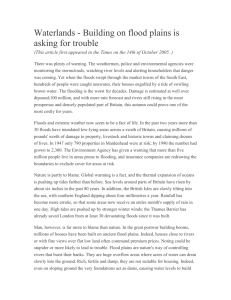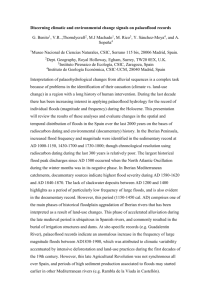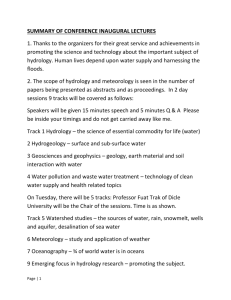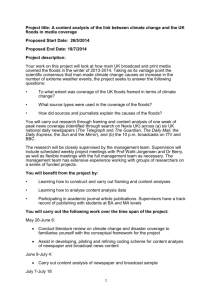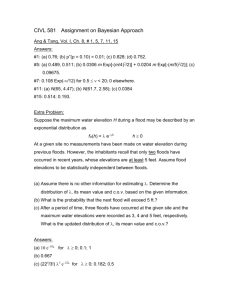STREAM ECOLOGY FLOODS AND FLOW REGIMES
advertisement
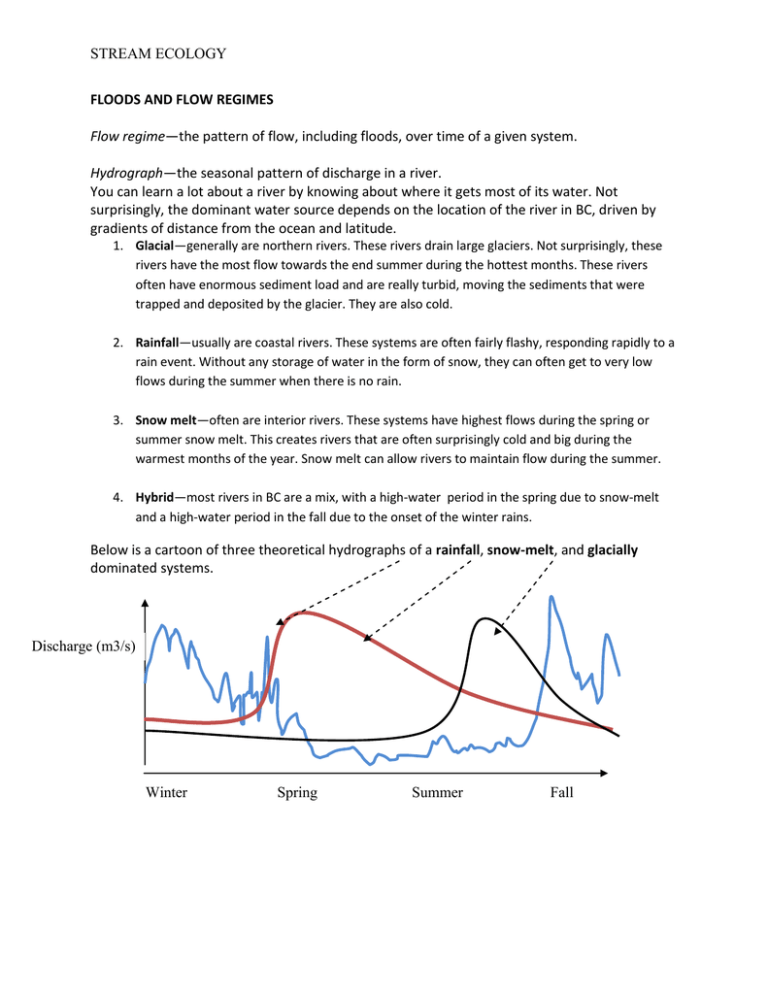
STREAM ECOLOGY FLOODS AND FLOW REGIMES Flow regime—the pattern of flow, including floods, over time of a given system. Hydrograph—the seasonal pattern of discharge in a river. You can learn a lot about a river by knowing about where it gets most of its water. Not surprisingly, the dominant water source depends on the location of the river in BC, driven by gradients of distance from the ocean and latitude. 1. Glacial—generally are northern rivers. These rivers drain large glaciers. Not surprisingly, these rivers have the most flow towards the end summer during the hottest months. These rivers often have enormous sediment load and are really turbid, moving the sediments that were trapped and deposited by the glacier. They are also cold. 2. Rainfall—usually are coastal rivers. These systems are often fairly flashy, responding rapidly to a rain event. Without any storage of water in the form of snow, they can often get to very low flows during the summer when there is no rain. 3. Snow melt—often are interior rivers. These systems have highest flows during the spring or summer snow melt. This creates rivers that are often surprisingly cold and big during the warmest months of the year. Snow melt can allow rivers to maintain flow during the summer. 4. Hybrid—most rivers in BC are a mix, with a high-water period in the spring due to snow-melt and a high-water period in the fall due to the onset of the winter rains. Below is a cartoon of three theoretical hydrographs of a rainfall, snow-melt, and glacially dominated systems. Discharge (m3/s) Winter Spring Summer Fall STREAM ECOLOGY Quantifying flow regime Stream flow regimes can be characterized by: Degree of intermittency o Perennial streams—streams that flow year-round. o Intermittent streams—streams that periodically go dry Magnitude o The discharge at a given point and time. Frequency o How often a flow above a given level occurs. For example, a 100-year flood is a flood that reaches a level that, on average, happens only once every 100 years. Duration o How long a given magnitude flow occurs. Predictability o In some systems, high flows are extremely predictable, happening at the same time each year. Alternatively, some systems have unpredictable floods. Flashiness (rate of change) o How quickly flow changes from one magnitude to another magnitude. You can understand a lot about a river by examining its flow regime. Rivers with different flow regimes have different communities, species with different adaptations, and different nutrient cycling. ALTERATIONS OF FLOW REGIMES One of the major global alterations of riverine ecosystems across the world has been alteration of flow regimes. Some scary stats: 172 out of 292 “large” river systems are affected by dams. There are >45,000 dams over 15 m high o Holds back ~6500 km3 of water (~15% of global river runoff) o E.g., Three Gorges Dam on the Yangtze River in China 181 m high >39 km3 There are an unknown number of smaller dams (from Nilsson et al. 2005) Human land use will make flows flashier STREAM ECOLOGY Impacts of floods on connectivity of streams Longitudinal connectivity—connections between upstream and downstream habitats. o Floods have great power and increase longitudinal connectivity. For example, they move large woody debris and sediments from the headwaters to lower down in the river. Lateral connectivity—connections between a stream and its floodplain. o Through periodically inundating floodplains, floods connect rivers with the landscape around them. This is important for both aquatic and riparian habitats. Therefore, floods blur the boundaries between aquatic and terrestrial habitats. What is dry land one day may be under 10 feet of water the next day. Through movements of materials, nutrients, and animals, floods connect rivers to their floodplain. The flood-pulse concept Floods in many natural systems are predictable events. Floods cause predictable advance and retreat of water onto the floodplain. Organisms and ecosystems have evolved in response to them. Because organisms are adapted to floods: o Increase biological productivity-- The floodplain regularly wetted and dried, which in term mobilizes and mineralizes nutrients. o Maintains diversity the this, is From: Bayley 1995. This shows fisheries yields are higher from flooding rivers. STREAM ECOLOGY Impacts of floods on stream communities Given that different organisms have different adaptations to floods and different vulnerabilities, the same flood will likely impact different species differently. Severe floods often dramatically reduce the abundance of benthic invertebrates and fishes. However, stream communities generally recover rapidly from floods, but it depends on the flood and the stream community. Species that are good at colonizing will generally be the first ones to show up. These species are usually short-lived species that are good at dispersal. Floods are an important selective agent and drive evolution They have stronger selection strength when they are: Predictable Frequent relative to the life-span of the organism Large in magnitude (Lytle and Poff 2004) Adaptations to flooding Life-history Behavioral Morphological

